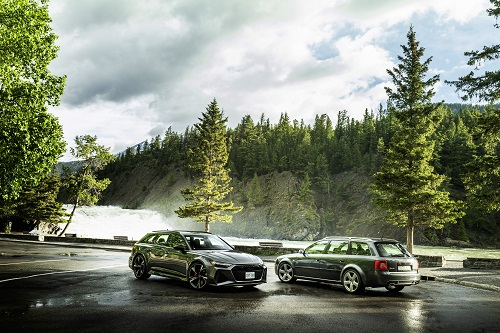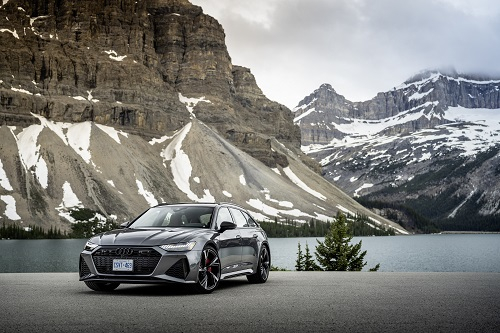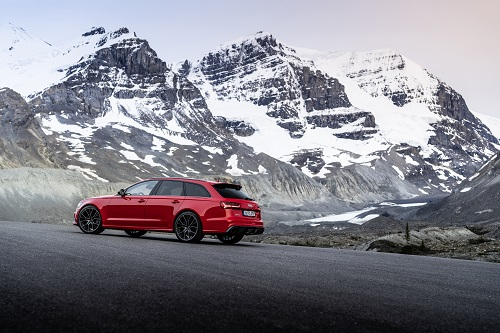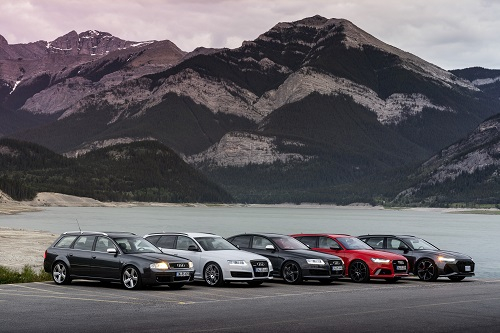One car has been exciting Audi Sport GmbH and a worldwide fanbase like no other for 20 years: across four generations, the Audi RS 6 has set the tone for high-performance station wagons with impressive performance and outstanding everyday usability. It owes the success of its underlying concept from 2002 to its double-charged engine and all-wheel drive. The basic concept has been the same across every generation of the RS 6. Again and again, it sets new standards in its competitive environment as well. Technical Vorsprung also turns up in other places, such as Dynamic Ride Control suspension. It has been used in other RS models from Audi for a long time.
The C5: a desire for performance in the upper mid-range
Shortly after the start of the new millennium, what was then quattro GmbH (now Audi Sport GmbH) was faced with the question of which car the staff would give a sporty renovation to after the RS 4. It was an opportune moment for the Audi A6. The first generation (C5) underwent a product enhancement in 2001 and Audi also wanted to add more power under the hood in its upper mid-range.
The brand was self-aware and motorsports were in high demand. Audi drove its way to the winners stand on the first try at its premiere in the legendary 24-hour Le Mans in 1999. The company with the four rings made history again in 2000, 2001, and 2002. With 13 wins, it is now the second-most successful team of all time in Le Mans after Porsche. The Audi engineers at quattro GmbH put a great deal of effort into making the A6 a sportscar. That meant not only adapting the engine, suspension, and transmission. Audi also shifted its appearance into a higher gear: it grew four centimetres (1.6 in) in both length and width. New skirts, wider sills, a spoiler for the Avant, a distinctive breakaway edge for the Sedan, 18” or 19” wheels, and two oval tailpipes emphasized its sporty ambitions.
In 2002, no other Audi had more power
The objective was to add an eight-cylinder to the basic design of the A8, series D2. The engine was already on the job in the S6, giving it 340 PS without charging. Nonetheless, it needed a lot of detail work: a powerful engine that from then on was double-turbocharged and had 4.2 litres of displacement did not fit in the body of the A6 at first. As a result, quattro GmbH extended the front end and gave the V8 four centimetres (1.6 in) more installation space. The engine that drove the first RS 6 was not fine-tuned in Ingolstadt or Neckarsulm, but in England. Together with quattro GmbH, British engine manufacturer Cosworth, which was a subsidiary of AUDI AG until 2004, was also responsible for the impressive 450 PS output and 560 Nm of torque. That put it at the top of the segment. The V8 in the RS 6 sent a real message to the competition. As a comparison, at the time, the DTM Audi from the ABT team, which Laurent Aïello used to bring home the 2002 title, also had 450 PS.
A lot of power requires good control. The era of the manual transmission was over. For the first time, a torque-converter transmission gave an RS model shorter shifting times for gear shifts. Five driving modes enabled acceleration to 100 km/h (62 mph) in 4.7 seconds. To make sure that the RS 6 Avant and Sedan impressed with their ideal spread between comfort and sportiness even in everyday driving, Audi now turned to the newly developed Dynamic Ride Control (DRC) suspension. Stephan Reil, who has been in charge of developing all the RS 6 series and is now Head of Technical Development at the Neckarsulm site, summarizes by saying that “the DRC reduces roll and pitch movements in sporty driving, both on straightaways and in curves.” In concrete terms, it binds the car more closely to the road and constantly ensures agile handling, particularly in dynamic cornering. Dynamic Ride Control consists of steel springs that have two diagonally opposite hydraulic shock absorbers. These counteract the motion in the body of the vehicle without any time lag and they do it without electronics. When the car is turning into or travelling around a bend, the damper response is altered so that the vehicle’s movements are significantly reduced along the longitudinal axis (roll) and the transverse axis (pitch).
All first-generation RS 6 vehicles (C5) were made both on the production line and by hand. Driveable, but far from complete. For instance, they lacked the filled suspension, RS-specific components, and individual decor elements in the interior. That is why they went from the plant in Neckarsulm to an adjacent hall. There quattro GmbH workers finalized each car individually over about 15 hours on the hydraulic lift.
To date, the C5 is the only RS 6 that is also a racing car from the start. The RS 6 Competition, which Champion Racing uses, outperformed its competitors with equal displacement in the 2003 SPEED GT World Challenge with Randy Pobst at the wheel. The V8 biturbo offered 475 PS, had a manual shift, and won on its first attempt.
At the end of the series, quattro GmbH added a shot of additional power and augmented the name with a “plus” as it went from 450 to 480 PS while the torque remained at 560 Nm. Now, a top speed of 280 km/h (174 mph) was possible, rather than 250 km/h (155 mph). Previously optional equipment became standard.
The C8: the best to date, but the work is never done
In 2019, three years before its 20th birthday, the fourth generation of the RS 6 (C8) rolled out to dealerships and stayed faithful to its heritage. Four-litres displacement, biturbo, 600 PS, and now 800 Nm of torque. For the first time in its history, this car is supported by a 48 volt mild hybrid system, improving efficiency even further. Although it is a bit heavier, the RS 6 Avant* races to 100 km/h (62 mph) in a brisk 3.6 seconds; it only needs twelve seconds to reach 200 km/h (124 mph). On straightaways, the C8 leaves little doubt. It also sets a new standard for itself in terms of lateral acceleration and cornering.
New all-wheel steering improves stability at high speeds, given that the rear wheels now turn in the same direction as the front wheels in those situations. When manoeuvring at low speeds, they turn in the opposite direction as the front wheels in order to reduce the turning radius and make parking easier. But hassle-free parking isn’t the only thing that’s important to customers. As in the earlier models, they also want to be able to take a trailer with them. “By now, more than half of our European customers order a trailer hitch,” says Stephan Reil. “That shows that customers don’t only want a sporty drive, they also want to meet everyday challenges,” Audi responded to customer demand and continued to offer those options, now with air as well as DRC suspension.
And the design? Where the C5, C6, and C7 generations of the RS 6 only stood out as power station wagons on the second look, the C8 creates a different impression: even lay people will recognize right away that this is no normal A6. The roof, front doors, and tailgate are the only things that the RS 6 Avant shares with the A6 Avant base model. The other components were altered specifically for the RS and the body was widened by a noticeable eight centimetres (3.15 in). Very few people know that the fastest of all A6 models also has an independent hood for the first time and that all these alterations mean that it can have the Matrix LED Headlights with laser lights from the RS 7. The wheels and tires also stand out as wider and taller. The 21” diameters (275/35) are standard equipment for the series; 22” (285/30) are available as an option for the first time. Unlike its predecessors, the C8 is not manufactured in separate halls – which have since been renamed Audi Sport GmbH – but rather roll off the assembly line in Neckarsulm ready for the showroom.
That’s an indication of how flexible these production sites are. And, in response to high demand, the C8 is available in the US for the first time as the RS 6 Avant. The RS 6* C8 is definitively evolving from a niche car into a success story that is in demand around the world.




